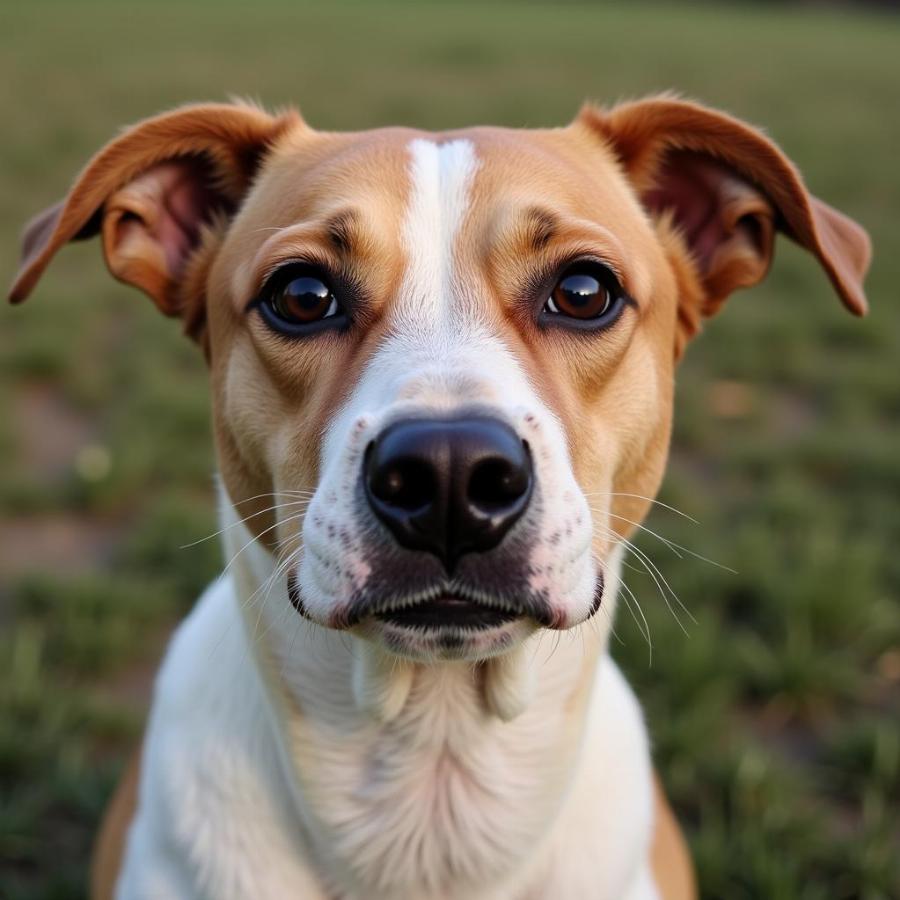The dog side eye gif. We’ve all seen it. That subtly tilted head, the slightly narrowed eyes, that unmistakable look that speaks volumes without uttering a single bark. But what does that “dog side eye gif” truly mean? Understanding your furry friend’s non-verbal cues is crucial to building a strong, loving relationship. This article dives deep into the world of canine communication, specifically focusing on the infamous side eye, and helps you decipher what your dog is really thinking.
Understanding the Nuances of Canine Communication
Dogs, unlike humans, rely heavily on body language to communicate. While barks, whines, and growls certainly play a role, a significant portion of their messaging comes from subtle shifts in posture, ear position, tail wags, and, of course, the side eye. Recognizing these subtle cues can help you better understand your dog’s emotions, needs, and intentions. A dog’s side eye can range from a curious glance to a skeptical stare, and everything in between.
 Chó nhìn nghiêng với vẻ mặt khó hiểu
Chó nhìn nghiêng với vẻ mặt khó hiểu
The Side Eye: Curiosity, Confusion, or Concern?
So, what’s the story behind the “dog side eye gif” you see all over the internet? It’s more than just a funny meme. The side eye often stems from a dog’s attempt to better understand a situation. It could be triggered by an unusual sound, a new object, or even your own behavior.
-
Curiosity: A slightly tilted head accompanied by a soft side eye might indicate your dog is intrigued by something. They’re trying to gather more information, using their keen senses to piece together the puzzle.
-
Confusion: A more pronounced head tilt and a furrowed brow alongside the side eye could signal confusion. Your dog might be struggling to understand your commands or the current situation.
-
Concern: Sometimes, the side eye can indicate apprehension or concern. This is often coupled with other body language cues like tucked ears, a lowered body posture, or lip licking.
Is Your Dog Judging You? The Truth Behind the “Shady” Side Eye
The internet is full of “dog side eye gif” memes depicting dogs giving their owners a judging look. While it’s fun to anthropomorphize our furry friends, it’s important to remember that dogs don’t experience complex emotions like judgment in the same way humans do. That “judgy” look might simply be a combination of confusion and concern. Maybe you’re doing something they don’t understand, or perhaps they’re picking up on your own emotional state.
How to Respond to Your Dog’s Side Eye
When your dog gives you the side eye, try to assess the context of the situation. What are you doing? What’s happening in the environment? Consider these factors:
- Reassure your dog: If your dog seems concerned, offer reassurance through gentle petting and a calm voice.
- Clarify your communication: If you think your dog is confused, try repeating your command in a simpler way or breaking down a task into smaller steps.
- Investigate the source of curiosity: If your dog appears curious, investigate what has captured their attention. It might be something harmless, or it could be a potential hazard.
Beyond the Side Eye: Other Important Canine Communication Cues
While the “dog side eye gif” is a captivating glimpse into canine communication, it’s important to consider the entire picture. Pay attention to other body language cues like tail wags, ear position, body posture, and vocalizations to get a comprehensive understanding of your dog’s emotional state. wiener dog pictures can show a wide variety of expressions, for example.
Conclusion: Decoding the Dog Side Eye Gif and Building a Stronger Bond
The “dog side eye gif” is a reminder of the rich and complex world of canine communication. By learning to interpret your dog’s subtle body language cues, including the side eye, you can build a deeper understanding and strengthen your bond. Don’t just see the funny meme – see the opportunity to connect with your furry companion on a deeper level. Remember, observing your dog’s body language is essential for responsible and loving pet ownership.
FAQ:
- Q: Does a dog’s side eye always mean they are judging me? A: No, dogs don’t experience judgment in the same way humans do. The “judging” look is often misinterpreted confusion or concern.
- Q: What other body language cues should I look for in my dog? A: Pay attention to tail wags, ear position, body posture, and vocalizations.
- Q: How can I improve my communication with my dog? A: Be clear and consistent with your commands, use positive reinforcement, and pay attention to your dog’s body language.
- Q: What should I do if my dog seems anxious or concerned? A: Offer reassurance through gentle petting and a calm voice. Remove them from the stressful situation if possible.
- Q: Can a dog’s side eye be a sign of a medical issue? A: While the side eye itself is usually behavioral, changes in behavior accompanied by other symptoms could indicate a medical problem. Consult your veterinarian if you have any concerns.
- Q: Are there resources available to help me learn more about dog body language? A: Yes, there are many books, websites, and online courses dedicated to canine communication.
Do you have other questions about dog behavior? Explore these related articles:
Beaut Dogs is your trusted source for all things canine. We are passionate about providing valuable information and guidance to dog lovers everywhere. From breed information to training tips, we’ve got you covered. When you need expert advice, contact us via Email: [email protected] to get detailed and accurate answers from Beaut Dogs. Visit us at https://beautdogs.com to explore the wonderful world of dogs!